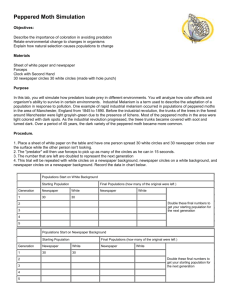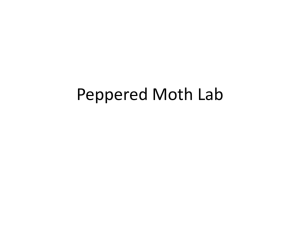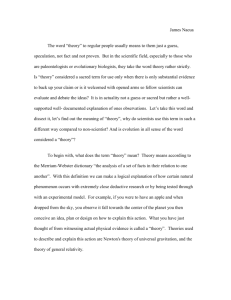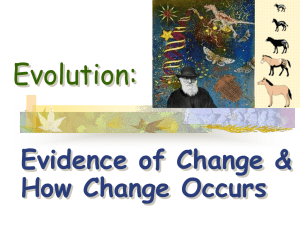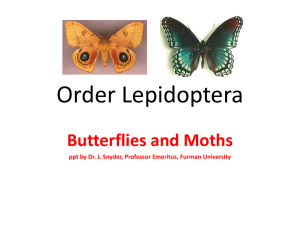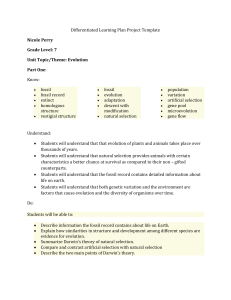Peppered Moths
advertisement
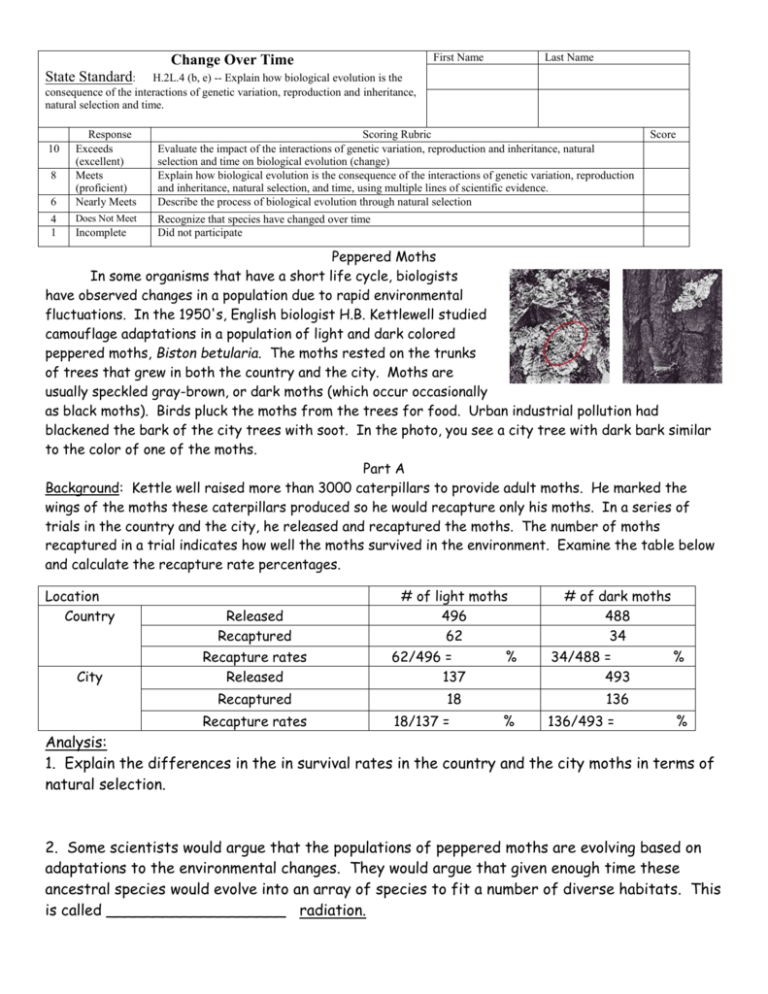
First Name Change Over Time Last Name State Standard: H.2L.4 (b, e) -- Explain how biological evolution is the consequence of the interactions of genetic variation, reproduction and inheritance, natural selection and time. 10 8 6 4 1 Response Exceeds (excellent) Meets (proficient) Nearly Meets Scoring Rubric Evaluate the impact of the interactions of genetic variation, reproduction and inheritance, natural selection and time on biological evolution (change) Explain how biological evolution is the consequence of the interactions of genetic variation, reproduction and inheritance, natural selection, and time, using multiple lines of scientific evidence. Describe the process of biological evolution through natural selection Does Not Meet Recognize that species have changed over time Did not participate Incomplete Score Peppered Moths In some organisms that have a short life cycle, biologists have observed changes in a population due to rapid environmental fluctuations. In the 1950's, English biologist H.B. Kettlewell studied camouflage adaptations in a population of light and dark colored peppered moths, Biston betularia. The moths rested on the trunks of trees that grew in both the country and the city. Moths are usually speckled gray-brown, or dark moths (which occur occasionally as black moths). Birds pluck the moths from the trees for food. Urban industrial pollution had blackened the bark of the city trees with soot. In the photo, you see a city tree with dark bark similar to the color of one of the moths. Part A Background: Kettle well raised more than 3000 caterpillars to provide adult moths. He marked the wings of the moths these caterpillars produced so he would recapture only his moths. In a series of trials in the country and the city, he released and recaptured the moths. The number of moths recaptured in a trial indicates how well the moths survived in the environment. Examine the table below and calculate the recapture rate percentages. Location Country City Released Recaptured Recapture rates Released Recaptured Recapture rates # of light moths 496 62 62/496 = 137 % 18 18/137 = # of dark moths 488 34 34/488 = 493 % 136 % 136/493 = % Analysis: 1. Explain the differences in the in survival rates in the country and the city moths in terms of natural selection. 2. Some scientists would argue that the populations of peppered moths are evolving based on adaptations to the environmental changes. They would argue that given enough time these ancestral species would evolve into an array of species to fit a number of diverse habitats. This is called ___________________ radiation. Procedure: Part B Simulation 1. Place a sheet of white paper on the table and have one person spread 30 white circles and 30 newspaper circles over the surface while the other person isn't looking. 2. The "predator" will then use forceps to pick up as many of the circles as he can in 15 seconds. 3. The number that are left are doubled to represent the next generation. 4. This trial will be repeated with white circles on a newspaper background, newspaper circles on a white background, and newspaper circles on a newspaper background. Record the data in the table. Generation 1 2 3 4 5 Generation 1 2 3 4 5 Starting Population Newspaper 30 Populations Start on White Background Final Populations (how many of the original were left) Double these White Newspaper White final numbers to 30 get your starting populations for the next generation Populations Start on Newspaper Background Starting Population Final Populations (how many of the original were left) Double these Newspaper White Newspaper White final numbers to 30 30 get your starting populations for the next generation Analysis: 1. Describe how the population of moths changed in each generation for both the newspaper and white moths. 2. What moth coloration is the best adapted for a dark (newspaper) background? ______________________________ 3. How does the simulation model natural selection? 4. Plot the data in the table below. Plot Year years on the x-axis and the number of moths on the y-axis. You should have 2 2 3 lines on your graph. 4 5. Suppose two Brazilian species of 5 6 butterflies with light or dark 7 colorations showed similar growth rates 8 as England's moths . Biologists would 9 10 consider this ___________________ evolution. (Hint: divergent or convergent) # light moths Captured 537 484 392 246 225 193 147 84 56 # dark moths Captured 112 198 210 281 337 412 503 550 599 # Years
